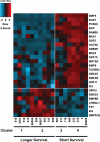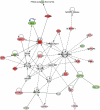High expression of BMP pathway genes distinguishes a subset of atypical teratoid/rhabdoid tumors associated with shorter survival
- PMID: 21946044
- PMCID: PMC3223096
- DOI: 10.1093/neuonc/nor140
High expression of BMP pathway genes distinguishes a subset of atypical teratoid/rhabdoid tumors associated with shorter survival
Abstract
Molecular profiling of tumors has proven to be a valuable tool for identification of prognostic and diagnostic subgroups in medulloblastomas, glioblastomas, and other cancers. However, the molecular landscape of atypical teratoid/rhabdoid tumors (AT/RTs) remains largely unexplored. To address this issue, we used microarrays to measure the gene expression profiles of 18 AT/RTs and performed unsupervised hierarchical clustering to determine molecularly similar subgroups. Four major subgroups (clusters) were identified. These did not conform to sex, tumor location, or presence of monosomy 22. Clusters showed distinct gene signatures and differences in enriched biological processes, including elevated expression of some genes associated with choroid plexus lineage in cluster 4. In addition, survival differed significantly by cluster, with shortest survival (mean, 4.7 months) in both clusters 3 and 4, compared with clusters 1 and 2 (mean, 28.1 months). Analysis showed that multiple bone morphogenetic protein (BMP) pathway genes were upregulated in the short survival clusters, with BMP4 showing the most significant upregulation (270-fold). Thus, high expression of BMP pathway genes was negatively associated with survival in this dataset. Our study indicates that molecular subgroups exist in AT/RTs and that molecular profiling of these comparatively rare tumors may be of diagnostic, prognostic, and therapeutic value.
Figures





Similar articles
-
Claudin 6 is a positive marker for atypical teratoid/rhabdoid tumors.Brain Pathol. 2010 Jan;20(1):140-50. doi: 10.1111/j.1750-3639.2008.00255.x. Epub 2009 Feb 9. Brain Pathol. 2010. PMID: 19220299 Free PMC article.
-
Immunohistochemical analysis of INI1 protein in malignant pediatric CNS tumors: Lack of INI1 in atypical teratoid/rhabdoid tumors and in a fraction of primitive neuroectodermal tumors without rhabdoid phenotype.Am J Surg Pathol. 2006 Nov;30(11):1462-8. doi: 10.1097/01.pas.0000213329.71745.ef. Am J Surg Pathol. 2006. PMID: 17063089
-
Recurrent atypical teratoid/rhabdoid tumors (AT/RT) reveal discrete features of progression on histology, epigenetics, copy number profiling, and transcriptomics.Acta Neuropathol. 2023 Sep;146(3):527-541. doi: 10.1007/s00401-023-02608-7. Epub 2023 Jul 14. Acta Neuropathol. 2023. PMID: 37450044 Free PMC article.
-
Advances in the molecular classification of pediatric brain tumors: a guide to the galaxy.J Pathol. 2020 Jul;251(3):249-261. doi: 10.1002/path.5457. Epub 2020 Jun 10. J Pathol. 2020. PMID: 32391583 Review.
-
Atypical teratoid rhabdoid tumors of childhood: diagnosis, treatment and challenges.Expert Rev Anticancer Ther. 2005 Oct;5(5):907-15. doi: 10.1586/14737140.5.5.907. Expert Rev Anticancer Ther. 2005. PMID: 16221059 Review.
Cited by
-
Inhibition of EZH2 suppresses self-renewal and induces radiation sensitivity in atypical rhabdoid teratoid tumor cells.Neuro Oncol. 2013 Feb;15(2):149-60. doi: 10.1093/neuonc/nos285. Epub 2012 Nov 28. Neuro Oncol. 2013. PMID: 23190500 Free PMC article.
-
Embryonal Tumors of the Central Nervous System in Children: The Era of Targeted Therapeutics.Bioengineering (Basel). 2018 Sep 23;5(4):78. doi: 10.3390/bioengineering5040078. Bioengineering (Basel). 2018. PMID: 30249036 Free PMC article. Review.
-
Targeting the enhancer of zeste homologue 2 in medulloblastoma.Int J Cancer. 2012 Oct 15;131(8):1800-9. doi: 10.1002/ijc.27455. Epub 2012 Jul 30. Int J Cancer. 2012. PMID: 22287205 Free PMC article.
-
Pediatric rhabdoid tumors of kidney and brain show many differences in gene expression but share dysregulation of cell cycle and epigenetic effector genes.Pediatr Blood Cancer. 2013 Jul;60(7):1095-102. doi: 10.1002/pbc.24481. Epub 2013 Feb 4. Pediatr Blood Cancer. 2013. PMID: 23382118 Free PMC article.
-
Current and Emerging Therapeutic Approaches for Extracranial Malignant Rhabdoid Tumors.Cancer Manag Res. 2022 Feb 9;14:479-498. doi: 10.2147/CMAR.S289544. eCollection 2022. Cancer Manag Res. 2022. PMID: 35173482 Free PMC article. Review.
References
-
- Louis DN. International Agency for Research on Cancer. World Health Organization. WHO classification of tumours of the central nervous system. 4th ed. Lyon: International Agency for Research on Cancer; 2007.
-
- Biegel JA, Tan L, Zhang F, Wainwright L, Russo P, Rorke LB. Alterations of the hSNF5/INI1 gene in central nervous system atypical teratoid/rhabdoid tumors and renal and extrarenal rhabdoid tumors. Clin. Cancer Res. 2002;8(11):3461–3467. - PubMed
-
- Judkins AR, Mauger J, Ht A, Rorke LB, Biegel JA. Immunohistochemical analysis of hSNF5/INI1 in pediatric CNS neoplasms. Am J Surg Pathol. 2004;28(5):644–650. doi:10.1097/00000478-200405000-00013. - DOI - PubMed
-
- Hilden JM, Meerbaum S, Burger P, et al. Central nervous system atypical teratoid/rhabdoid tumor: results of therapy in children enrolled in a registry. J Clin Oncol. 2004;22(14):2877–2884. doi:10.1200/JCO.2004.07.073. - DOI - PubMed
-
- Chen ML, McComb JG, Krieger MD. Atypical teratoid/rhabdoid tumors of the central nervous system: management and outcomes. Neurosurg Focus. 2005;18(6A):E8. - PubMed
Publication types
MeSH terms
Substances
Grants and funding
LinkOut - more resources
Full Text Sources
Molecular Biology Databases

